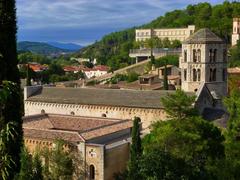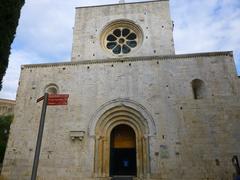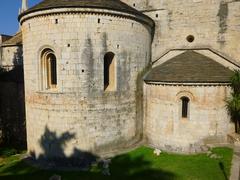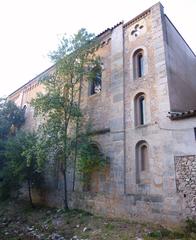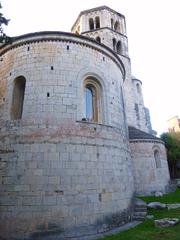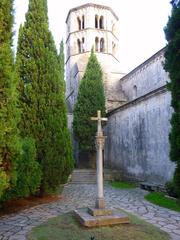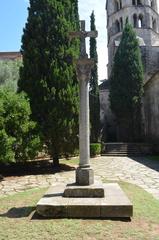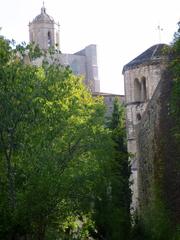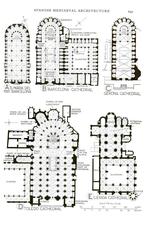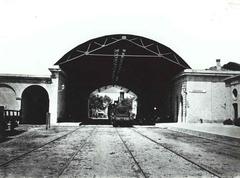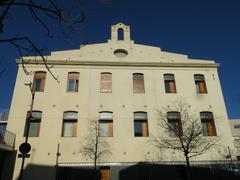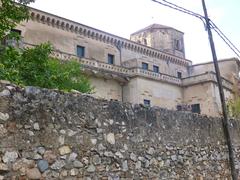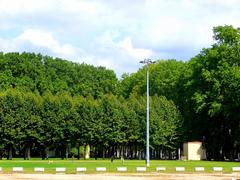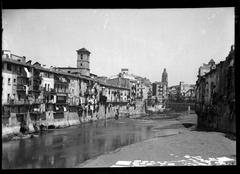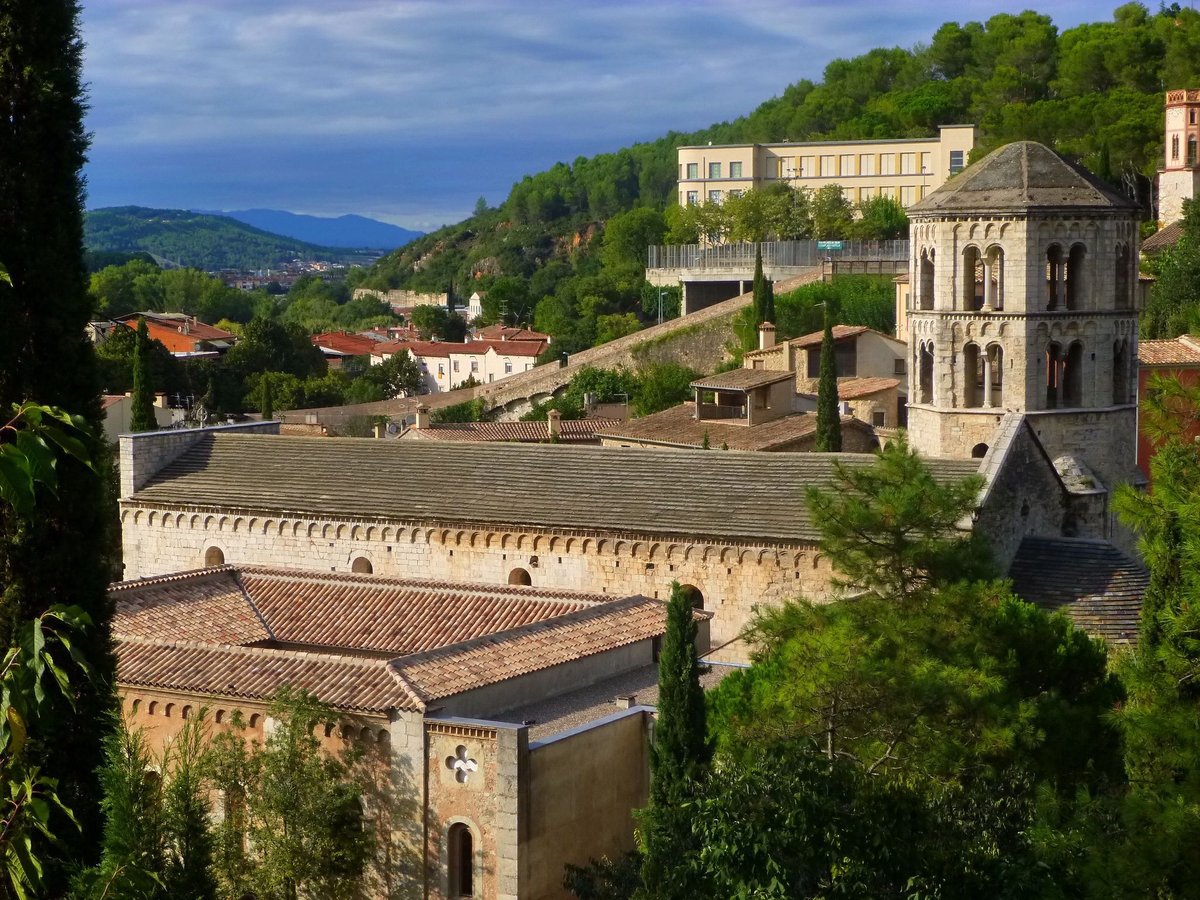
Sant Pere de Galligants: Visiting Hours, Tickets, and Girona Historical Sites Guide
Date: 14/06/2025
Introduction
Sant Pere de Galligants is a stunning example of Catalonia’s Romanesque heritage, standing on the edge of Girona’s Old Town by the Galligants River. Originally a 10th-century Benedictine monastery, it played a central role in the region’s religious, cultural, and architectural development. Today, it houses the Museu d’Arqueologia de Catalunya (MAC-Girona), making it both a monument to Girona’s medieval past and a vibrant center for archaeological study.
This guide provides a comprehensive overview of Sant Pere de Galligants, covering its history, architectural highlights, visiting information, accessibility, and practical tips for making the most of your visit. For up-to-date opening hours, ticket prices, and special events, always check the official MAC Girona website before your visit. (patrimoni.gencat.cat; Catalunya Turisme; Happy Little Traveler)
Table of Contents
- Historical Overview
- Architectural Features
- Museum and Collections
- Visiting Information
- Accessibility and Facilities
- Nearby Attractions
- Visitor Tips
- Frequently Asked Questions (FAQ)
- Conclusion
- Sources and Further Reading
Historical Overview
Origins and Early Development
Sant Pere de Galligants was founded as a Benedictine monastery in the 10th century, with its first documented mention in 988 CE. The name “Galligants” comes from the river running alongside the monastery, a strategic location just outside Girona’s early walls. Its establishment reflected the broader movement of Christian repopulation and monastic expansion that shaped Catalonia during the Middle Ages. (patrimoni.gencat.cat)
Romanesque Flourishing
The current structure dates mainly from the 12th century (1130–1150), a period when Romanesque architecture reached its maturity in Catalonia. The monastery’s basilica-plan church, rectangular cloister, and distinctive bell tower showcase the harmonious proportions and sculptural decoration typical of the era. The cloister, with its paired columns and sculpted capitals, is a masterpiece of Romanesque art, reflecting both local and broader European influences. (Catalunya Turisme)
Medieval Significance and Decline
Throughout the Middle Ages, Sant Pere de Galligants was a religious and cultural hub, with monks engaged in prayer, manuscript production, and regional administration. Its fortunes waned in the late Middle Ages due to political instability and changing religious practices. In 1835, the monastery was secularized during Spain’s Desamortización, and its buildings were repurposed. (thecrazytourist.com)
Modern Transformation
Declared a national monument in 1857, Sant Pere de Galligants became the home of the Museu d’Arqueologia de Catalunya in Girona, one of Spain’s oldest archaeological museums. This transition preserved its architectural heritage while repurposing the space for educational and cultural activities. (macgirona.cat)
Architectural Features
The Church
The church at Sant Pere de Galligants follows a Latin cross plan with a nave flanked by aisles, a prominent transept, and four apses. The nave and aisles are separated by robust pillars with semicircular arches, characteristic of Romanesque style. Capitals are decorated with vegetal motifs and biblical scenes, adding artistic richness to the austere Benedictine interior. (Catalunya Turisme)
The Cloister
One of the highlights is the 12th-century cloister, featuring four vaulted galleries with double columns and over 50 unique carved capitals. These capitals depict biblical narratives, daily life, animals, and mythical creatures—each a unique work of art. Scholars debate the origins of these carvings, variously attributing them to the Master of Cabestany or the School of Toulouse. (MAC Girona)
The Bell Tower
The octagonal bell tower exemplifies Lombard Romanesque style, with two levels of double arches and decorative Lombard bands. Rising above the crossing, it is a prominent feature of Girona’s skyline. (Wikipedia)
Façade and Rose Window
The west façade is dominated by a large rose window, 3.5 meters in diameter, surrounded by concentric stone circles, and flanked by arches with sculpted capitals. The main portal, likely preserved from an earlier building phase, is simpler in style, offering a contrast to the richly decorated interiors. (Wikipedia)
Museum and Collections
Since 1857, Sant Pere de Galligants has housed the Museu d’Arqueologia de Catalunya’s Girona branch. The museum’s collections span prehistory to the Middle Ages, with a strong focus on artifacts from Girona and the surrounding region. Highlights include:
- Prehistoric tools and ceramics
- Iberian and Roman artifacts
- Visigothic sarcophagi and medieval religious objects
- Funerary stelae and epigraphic inscriptions
Temporary exhibitions, interactive displays, and educational programs make the museum engaging for visitors of all ages. (MAC Girona)
Visiting Information
Opening Hours (as of November 2024)
- Tuesday to Saturday: 10:00 AM – 6:00 PM
- Sundays and public holidays: 10:00 AM – 2:00 PM
- Closed on Mondays (except public holidays)
Note: The museum may close for maintenance or special events. Check the official website before visiting.
Ticket Prices
- General admission: €7
- Reduced admission: €5 (students, seniors, and eligible groups)
- Free entry: First Sunday of each month and for children under 16
Tickets can be purchased at the entrance or online. Advance booking is recommended for groups and guided tours. (MAC Girona)
Accessibility and Facilities
- Accessibility: Main exhibition areas are generally accessible, though some historic sections have steps or uneven surfaces. Wheelchair users should contact the museum in advance for detailed accessibility information.
- Facilities: Restrooms and a gift shop are on-site; several cafés and restaurants are nearby in the Old Town.
- Guided Tours: Regular tours and themed walks are available in multiple languages. Audio guides can be rented or downloaded via the museum app.
- Photography: Allowed in most areas without flash or tripods. Always check signage for restrictions.
Nearby Attractions
Sant Pere de Galligants is located at Carrer de Santa Llúcia, 8, in Girona’s historic quarter. Its central location makes it easy to combine a visit with other landmarks:
- Girona Cathedral: Featuring the world’s widest Gothic nave
- Arab Baths: A well-preserved 12th-century bathhouse
- Jewish Quarter (El Call): One of Europe’s best-preserved medieval Jewish neighborhoods
- City Walls: Offering panoramic city views
All are within easy walking distance, allowing for a full day of exploration. (Happy Little Traveler)
Visitor Tips
- Best Time to Visit: Early mornings or late afternoons are quieter. Free entry on the first Sunday each month may draw more visitors.
- Climate: Girona has a mild climate, but summer can be warm. The monastery’s stone walls provide natural coolness.
- Language: Information is available in Catalan, Spanish, and English. English-language tours are offered periodically.
- Safety: Eating, drinking, and smoking are not allowed inside. Children should be supervised, especially near artifacts and uneven floors.
Frequently Asked Questions (FAQ)
Q: What are Sant Pere de Galligants’ opening hours?
A: Tuesday to Saturday, 10:00–18:00; Sundays/public holidays, 10:00–14:00; closed Mondays (except public holidays).
Q: How much do tickets cost?
A: General admission is €7; reduced tickets are €5; free for children under 16 and on the first Sunday of each month.
Q: Is the site accessible for wheelchair users?
A: Main areas are accessible, but some sections may have steps. Contact the museum for details.
Q: Are guided tours available?
A: Yes, guided and themed tours are offered regularly. Advance booking is recommended.
Q: Can I take photos?
A: Yes, in most areas, but flash and tripods are prohibited.
Conclusion
Sant Pere de Galligants is a jewel of Romanesque architecture and a key site for anyone interested in Girona’s medieval past. Its stunning cloister, robust bell tower, and rich museum collections offer a multi-layered experience, blending history, art, and archaeology. The monastery’s integration into Girona’s network of historical sites makes it an essential stop on any cultural itinerary.
For the latest visiting details, tickets, and special events, consult the MAC Girona website. Enhance your visit with guided tours and interactive resources, and consider using the Audiala app for up-to-date travel tips and exclusive content.
Sources and Further Reading
- patrimoni.gencat.cat
- Catalunya Turisme
- Museu d’Arqueologia de Catalunya
- Girona Turisme
- Spain.info
- MAC Girona
- The Crazy Tourist
- Happy Little Traveler
